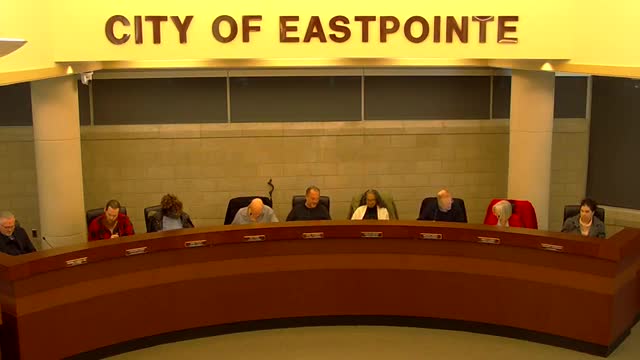Commission discusses zoning amendments for signs, murals and event‑space definitions
January 02, 2025 | Eastpointe City, Macomb County, Michigan
This article was created by AI summarizing key points discussed. AI makes mistakes, so for full details and context, please refer to the video of the full meeting. Please report any errors so we can fix them. Report an error »

Planning staff introduced proposed zoning‑ordinance amendments intended to reduce administrative ambiguity and clarify standards for event spaces, sign regulation, murals, and nonconforming signage.
Kim Smith, zoning administrator, outlined two primary goals: clarify land‑use designations (especially to distinguish event‑based businesses from ordinary retail or office uses) and refine the sign and lighting rules, including the rules for nonconforming signs, how window‑sign area is calculated, and the setback standard for pole signs. Smith proposed that a “change in occupancy” — which triggers removal of nonconforming signs — should be defined to include both a change in business type and a change in business ownership; she also proposed removing a phrase in the wall‑sign definition that currently treats permanent window signs as wall signs, to prevent conflation of window and wall signage.
Smith proposed measuring window‑sign area on a per‑street‑frontage basis (one‑third of total window area per frontage) to prevent a business from covering all windows on one side of a building. She recommended changing pole‑sign setback measurement from 10 feet from the property line/sidewalk to 10 feet from the curb line (matching the approach already used on Kelly Road) to reduce the cost of relocating existing pole signs and to avoid creating dead space on small lots.
Commissioners discussed painted wall signs versus murals and whether painted wall signage that functions as advertising should be regulated more strictly. Smith noted the current ordinance treats murals as not signs but allows murals only with zoning administrator approval and includes criteria to prevent murals from acting as advertising (for example, murals should not be primarily worded advertisements). Commissioners asked staff to research other communities’ approaches to painted wall signs and returned definitions for “event space” and “special event,” to better align code language with administrative enforcement and public‑safety requirements.
Building official Michael Myers described the department’s recent work documenting signs across the city and removing illegal temporary signs; he supported clearer definitions and stronger enforcement tools. Commissioners signaled broad interest in the changes and asked staff to refine draft language and return with a formal ordinance amendment for public hearing and vote.
Kim Smith, zoning administrator, outlined two primary goals: clarify land‑use designations (especially to distinguish event‑based businesses from ordinary retail or office uses) and refine the sign and lighting rules, including the rules for nonconforming signs, how window‑sign area is calculated, and the setback standard for pole signs. Smith proposed that a “change in occupancy” — which triggers removal of nonconforming signs — should be defined to include both a change in business type and a change in business ownership; she also proposed removing a phrase in the wall‑sign definition that currently treats permanent window signs as wall signs, to prevent conflation of window and wall signage.
Smith proposed measuring window‑sign area on a per‑street‑frontage basis (one‑third of total window area per frontage) to prevent a business from covering all windows on one side of a building. She recommended changing pole‑sign setback measurement from 10 feet from the property line/sidewalk to 10 feet from the curb line (matching the approach already used on Kelly Road) to reduce the cost of relocating existing pole signs and to avoid creating dead space on small lots.
Commissioners discussed painted wall signs versus murals and whether painted wall signage that functions as advertising should be regulated more strictly. Smith noted the current ordinance treats murals as not signs but allows murals only with zoning administrator approval and includes criteria to prevent murals from acting as advertising (for example, murals should not be primarily worded advertisements). Commissioners asked staff to research other communities’ approaches to painted wall signs and returned definitions for “event space” and “special event,” to better align code language with administrative enforcement and public‑safety requirements.
Building official Michael Myers described the department’s recent work documenting signs across the city and removing illegal temporary signs; he supported clearer definitions and stronger enforcement tools. Commissioners signaled broad interest in the changes and asked staff to refine draft language and return with a formal ordinance amendment for public hearing and vote.
View full meeting
This article is based on a recent meeting—watch the full video and explore the complete transcript for deeper insights into the discussion.
View full meeting
